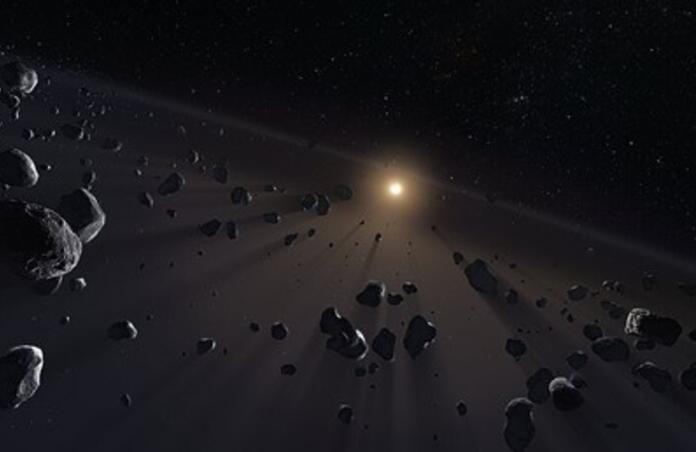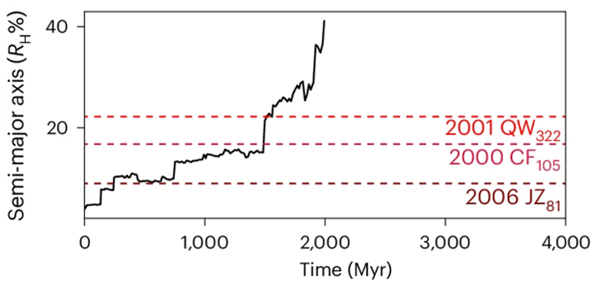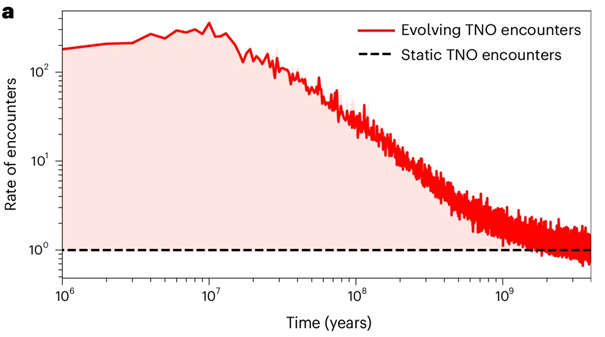Rethinking the Formation of Ultra-Wide Binaries in the Kuiper Belt

Beyond the outskirts of the Solar System lies the cold classical belt (CCB), a stable region within the Kuiper Belt. This area is characterized by objects with nearly circular orbits that stay close to the ecliptic plane, moving at relatively low, or "cold," speeds compared to other trans-Neptunian objects (TNOs). Nearly one-third of its members exist as ultra-wide binaries (UWBs), where pairs of objects, typically tens of kilometres across, orbit each other at distances of tens of thousands of kilometres. At such vast separations, the gravitational forces binding them are exceedingly weak. Due the dynamic fragility of such systems, it is generally accepted that UWBs must have formed early in our history and left undisturbed until today. As such, their orbits provide of snapshot of the Solar System’s early dynamics.
However, a new study led by Hunter Campbell challenges this assumption, presenting a mechanism through which such systems may form much later than previously thought. This discovery calls into question studies which may have relied on the motions of UWBs to constrain early Solar System development.

The team utilized a modified SWIFT integrator to simulate the orbital evolution of binary objects within the CCB. SWIFT integrators are a class of algorithms designed to solve differential equations while balancing calculation speed and stability. These are particularly effective for long-term simulations, as they focus on energy and momentum conservation within the system. This conservation is crucial, as small inaccuracies in a simulation can be greatly magnified if the system evolves over long periods without correction.
The study suggests that UWBs were initially tightly wound, and their separation was later magnified by gravitational interactions with other nearby TNOs. The investigation posits that while the CCB remains stable, the rest of the so-called dynamic Kuiper belt is not, noting that the early Kuiper belt had a significantly larger population than today by two or three orders of magnitude. These objects would have been scattered and subsequently may interact with or pass through the CCB. Indeed, their simulations demonstrated the high number of interactions between objects in the CCB and other TNOs early on, which decreased over time.

The study primarily focuses on a period of history during which Neptune migrated outwards. This significantly scattering the orbits of inner planetesimals, which were ejected outward. To simulate the evolution of a binary's orbit, the team subjected tightly wound binaries to flybys at the rates shown in fig 2. They find that the minute gravitational perturbations exerted by these objects imparted gradual velocity changes. Assuming these remained small, these would inject the binary with energy without disrupting the system, expanding the orbital separation. This accumulation of minor changes could allow binaries to reach the ultra-wide separations observed today. Indeed, the study finds that evolving binary orbits in this way leads to a distribution of separations, eccentricities and inclinations similar to what can be seen today, which is very promising.
Campbell et al.'s findings indicate that many of today’s UWBs may not be primordial systems but products of long-term gravitational interactions. This shift suggests they might not provide direct insights into the Solar System’s earliest conditions, as previously thought, instead reflecting later evolutionary processes within the dynamically active Kuiper Belt. Prior studies largely focused on the effects of direct collisions by TNOs on UWBs, which can disrupt these fragile binaries. However, Campbell’s team demonstrates that close gravitational encounters are an equally, if not more, significant factor in shaping UWB orbits, especially given the tendency of larger separations to amplify the effects of successive encounters over time.
--
Journal Source: H. Campbell et al, A non-primordial origin for the widest binaries in the Kuiper belt, Nature, (2024), DOI: https://doi.org/10.1038/s41550-024-02388-4
Cover Image Credit: ESO/M. Kornmesser
